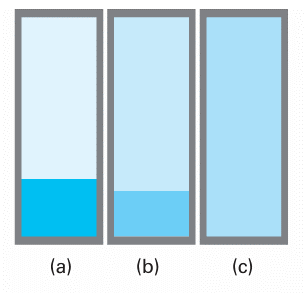
Critical points and boiling points
 المؤلف:
Peter Atkins، Julio de Paula
المؤلف:
Peter Atkins، Julio de Paula
 المصدر:
ATKINS PHYSICAL CHEMISTRY
المصدر:
ATKINS PHYSICAL CHEMISTRY
 الجزء والصفحة:
ص118-119
الجزء والصفحة:
ص118-119
 2025-11-10
2025-11-10
 66
66
Critical points and boiling points
When a liquid is heated in an open vessel, the liquid vaporizes from its surface. At the temperature at which its vapour pressure would be equal to the external pressure, vaporization can occur throughout the bulk of the liquid and the vapour can expand freely into the surroundings. The condition of free vaporization throughout the liquid is called boiling. The temperature at which the vapour pressure of a liquid is equal to the external pressure is called the boiling temperature at that pressure. For the special case of an external pressure of 1 atm, the boiling temperature is called the normal boiling point, Tb. With the replacement of 1 atm by 1 bar as standard pressure, there is some advantage in using the standard boiling point instead: this is the temperature at which the vapour pressure reaches 1 bar. Because 1 bar is slightly less than 1 atm (1.00 bar = 0.987 atm), the standard boiling point of a liquid is slightly lower than its normal boiling point. The normal boiling point of water is 100.0°C; its standard boiling point is 99.6°C. Boiling does not occur when a liquid is heated in a rigid, closed vessel. Instead, the vapour pressure, and hence the density of the vapour, rise as the temperature is raised (Fig. 4.3). At the same time, the density of the liquid decreases slightly as a result of its expansion. There comes a stage when the density of the vapour is equal to that of the remaining liquid and the surface between the two phases disappears. The temperature at which the surface disappears is the critical temperature, Tc, of the substance. We f irst encountered this property in Section 1.3d. The vapour pressure at the critical temperature is called the critical pressure, pc. At and above the critical temperature, a single uniform phase called a supercritical fluid fills the container and an interface no longer exists. That is, above the critical temperature, the liquid phase of the substance does not exist.

Fig. 4.3 (a) A liquid in equilibrium with its vapour. (b) When a liquid is heated in a sealed container, the density of the vapour phase increases and that of the liquid decreases slightly. There comes a stage, (c), at which the two densities are equal and the interface between the fluids disappears. This disappearance occurs at the critical temperature. The container needs to be strong: the critical temperature of water is 374°C and the vapour pressure is then 218 atm.
 الاكثر قراءة في مواضيع عامة في الكيمياء الفيزيائية
الاكثر قراءة في مواضيع عامة في الكيمياء الفيزيائية
 اخر الاخبار
اخر الاخبار
اخبار العتبة العباسية المقدسة


